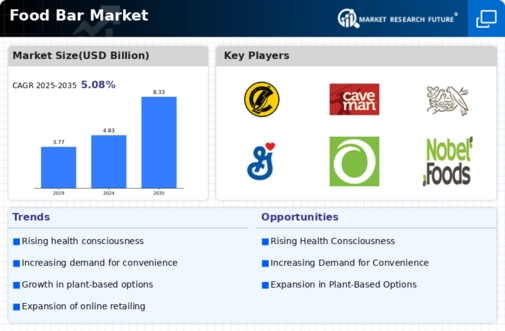Leading market players are investing heavily in research and development to expand their product lines, which will help the Food Bar market grow even more. Market participants are also undertaking several strategic activities to spread their footprint, with important market developments including new product launches, contracts, agreements, mergers and acquisitions, higher investments, and integration with other organizations. The Food Bar industry must offer cost-effective items to expand and survive in a more competitive and rising market climate.
Manufacturing locally to minimize operational costs is one of the key business tactics manufacturers use in the Food Bar industry to benefit clients and increase the market sector. In recent years, the Food Bar industry has offered some of the most significant advantages to medicine.
Major players in the Food Bar market, including Cliff Bar & Company (US), Caveman Foods (US), Atkins Nutritionals Inc. (US), Kellogg Co. (US), Quaker Oats Company (US), Nestle (Switzerland), General Mills Inc. (US), Annie's Homegrown Inc. (US), Orgain, Inc. (US), Nobel Foods (UK), Davis Chocolate (US), Small Planet Foods (US), Bridgetown Natural Food (US), Hearthside Food Solutions LLC (US), Premier Nutrition Corporation (US), Amway Corp. (US), Post Holdings (US), and others, are attempting to increase market demand by investing in research and development operations.
Clif Bar & Company, founded in 1992, located in Emeryville, California, United States, is an American that produces energy foods and drinks. It is a subsidiary company of Mondelez International. It makes various energy bars tailored to women and children, sports drinks, and fruit-based items like fruit ropes. All these products use organic ingredients. In January 2021, Clif Bar & Company launched a new thin, crispy energy snack bar called CLIF BAR Thins. These come in three flavors, i.e., chocolate chip, chocolate peanut brownie, and white chocolate macadamia nut.
The product contains 100 calories, 5 g of sugar, and plant-based organic ingredients like rolled oats.
PROBAR LLC, founded in 2003 in Salt Lake City, Utah, is a food and beverage services industry. It creates delicious, convenient, healthy plant-based food products. It is the leading provider of real food choices with commitment, quality, sustainability, and fantastic taste. It sources all-natural, real, wholesome, and organic ingredients to create delicious food. In November 2019, PROBAR LLC introduced two new PROBAR Meal Bar flavors, blueberry muffins and more. These additions include at least 9g of protein per serving, are 100% plant-based, gluten-free, and are made from whole superfoods.




















